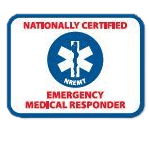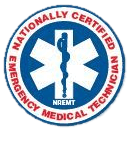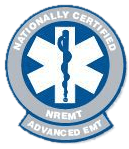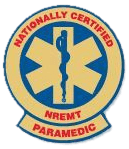Please email any corrections direct to us.
EMT licensure levels
A National Scope of Practice Model was developed to describe the responsibilities of different members of the emergency medical system. There were five old levels of licensure that were converted into 4 new levels due to the scope of practice guidelines. Following are the new nationally certified licensure levels.
 |
 |
 |
 |
Emergency medical responderPossesses basic lifesaving knowledge and skills necessary to initiate immediate care for critical patients. |
Emergency medical technicianProvide basic medical care for critical patients during transport. Provide intervention as necessary. |
Advanced EMTPerforms basic and advanced intervention for patients during transport to the emergency care system. |
ParamedicPerforms basic and advanced intervention. Handles complex decisions during transport to emergency care. |
Background information:
- National EMS Scope of Practice Model — The 2019 NHTSA guide defining the role of EMS in the United States healthcare model, with broad consensus by all 50 states.
- NREMT recertification guide — The 2019 NREMT guide to recertification.
National Continued Competency Program
The National Continued Competency Program (NCCP) is required to renew EMS certification. There are several different types of education including live learning (which has no limit) or distributive education. Distributive education (DE) is an educational activity where the learner and instructor are not present at the same time and unable to interact. To count for recertification credit, the course should be state EMS office recognized or accredited. For each of the CE courses, you cannot repeat the same course per each registration cycle.
The NCCP has three components that span different areas:
- National component: The national component requirements are updated every four years and represent half of the overall requirements to renew certification. Information related to the NCCP national component educational topics can be found here. Topics for continuing education (CE) include:
-
- Evidence-based medicine
- Changes in National Scope of Practice Model
- Science-based papers about EMS patient care
- Low-frequency patient care tasks that are critical
- Peer-reviewed articles in EMS
- Local component: The local component is created at the local or state EMS level and represents one-quarter of the recertification requirements for all provider levels. The topics may be determined by state or regional EMS offices. However, some states permit agency-level administrators to dictate this compoment. These courses are about:
-
- Changes in local protocols
- Run reviews
- Grand rounds
- Community-based needs
- Remediation tasks related to quality assurance (QA)
- National EMS information services (NEMSIS)
- Individual component: The individual component represents one-quarter of the required CE. There are no limitations on the number of hours in a specific topic.
| Level | # CEU Hours | National | Local | Individual | Total |
|---|---|---|---|---|---|
| EMR | Total | 8 | 4 | 4 | 16 |
| DE | 3 | 3 | 4 | 10 | |
| EMT | Total | 20 | 10 | 10 | 40 |
| DE | 7 | 7 | 10 | 24 | |
| AEMT | Total | 25 | 12.5 | 12.5 | 50 |
| DE | 8 | 8 | 12.5 | 28.5 | |
| NRP | Total | 30 | 15 | 15 | 60 |
| DE | 10 | 10 | 15 | 35 |
How long is a recertification cycle for EMS?
Certification cycles start on the day the recertification application is processed and approved by the National Registry. The new expiration is two years after the current expiration date on your account.
Do EMS providers need to take ACLS?
Under the NCCP, EMS providers do not need to take ACLS. However, all emergency medical personnel benefit tremendously when they are ACLS certified.
Transition information
As part of the Scope of Practice guidelines, the five old levels of licensure will be converted into 4 new levels. Following is a list of your transition plan and the timeline you must complete this transition by.
| Old designation | New designation | Transition deadline | Transition guide |
|---|---|---|---|
| EMT-basic | Emergency medical technician (EMT) | March 31, 2015* | EMT-basic to emergency medical eechnician (EMT) |
| First responder | Emergency medical responder (EMR) | September 30, 2015* | First responder to emergency medical responder (EMR) |
| EMT-I/85 | Advanced emergency medical technician (AEMT) | March 31, 2015* | EMT-I/85 to advanced emergency medical technician (AEMT) |
| EMT-I/99 | Paramedic (NRP) | March 31, 2017* | EMT-I/99 to paramedic (NRP) |
| EMT-paramedic | Paramedic (NRP) | March 31, 2015* | EMT-paramedic to paramedic (NRP) |
* For people that renewed after 2011 under an old designation, you may have an extra year for transition, see details in the PDF guide.
NOTICE: EMT-intermediate 99s will transfer to NRP, this will add the requirement for ACLS certification during your transfer.
More information
Check these guides for details:
 First responder (xfer to NREMR) |
 EMT-basic (xfer to NREMT) |
 Intermediate-85 (xfer to NRAEMT) |
 Intermediate-99 (xfer to NRP) |
 Paramedic (xfer to NRP) |
 EMR |
 EMT |
 AEMT |
 Paramedic |